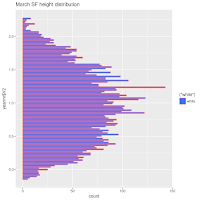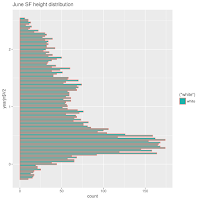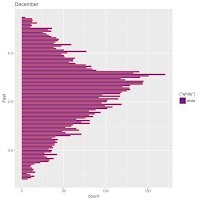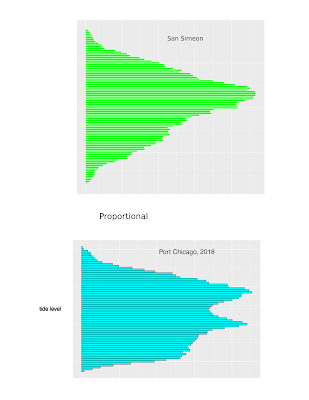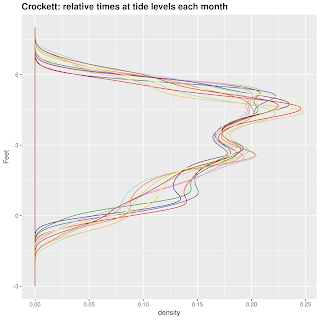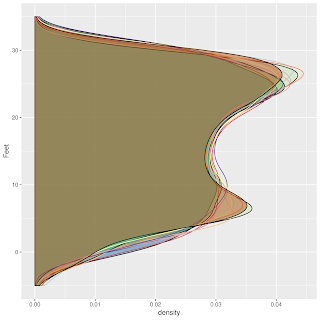I'll try any kind of graph. Distribution frequency plots are described in Pugh's 1984 Sea Level Science. I saw a beeswarm plot, don't remember where; it seemed an interesting way to do a distribution frequency plot.
In a beeswarm plot, data is plotted along a single axis, in this case, tide water levels. No overlapping points are allowed; each overlapping point is "jittered" off to one side of the other point(s) at the
Are beeswarm plots informative? i tried. As usual I had to fiddle (speaking of which, a "violin plot" does something similar. Perhaps I'll try one). The "beeswarm" package for R makes production of these plots pretty easy. My first attempt suggested to me that a smaller amount of data might be more manageable. Eventually, something like this appeared, for St Petersburg, FL:
A first approximation: Predictions for June 17--28
Does the Moon figure into the distribution of water levels. I think this information is useful when considering intertidal zonation. The following is a beeswarm plot for hourly predictions for June, from New Moon to First
Quarter June 17--26). What, then, is this prominaent horizontal feature
Comparing with a plot for a couple of these days
Below, the same plot has been placed together with a plot of the tide at St Petersburg for two days in this period of time. The hold ups
seem to be encoded as the horizontal line
A Month at a Time
As a first approximation, I wondered whether it would be useful to divide time into quarter moons. The first reason: a useful number of points plotted on a single vertical beeswarm axis looks stupidly cluttered. Maybe it would be easier to plot short periods of time, like a month? No, a month was waaay to cluttered. A week looked alright.
A month at a time
So I used quarter moons. I have some misgivings about this choice. Next time I may CENTER the time division on a full moon, quarter moon, or new moon. Here, while it looks interesting, I'm pretty sure that much information about the actual full or new moon's influence.
I like it. It says something. The tides of St Petersburg exhibit some interesting quirks, reflected in these plots.
These are Beeswarm plots, a kind of univariate distribution plot, like histograms, and maybe a stem and leaf diagram of a kind. Each vertical plot represents a week (or so), hourly predictions for a quarter of the moon. Black, for example, represents the span between New Moon and First Quarter.
Maybe an inverted colorscheme would look better on the screen. The following was inverted in The Gimp, and exported as PNG, from a PDF.
Each vertical plot is a distribution plot, for one Quarter of a Lunar Cycle. The first one, in January, represents the period between NM and First Quarter (Q1), then Q1-> FM; FM -> Q3; Q3->NM, etc. 48 of these quarters are represented, from January into December of 2019.
These are predictions, from Xtide.
I don't know why almost everywhere I graph a tide, no matter how, something interesting pops up! What are we visualizing here?

